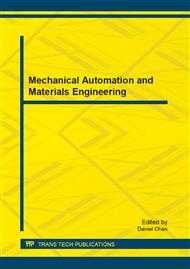[1]
AWS B4. 0: 2007. Standard Methods for Mechanical Testing of Welds. (2007).
Google Scholar
[2]
Miazga G.S., Kennedy D.J.L. Behavior of fillet welds as a function of the angle of loading. Structural Engineering Report No. 133, University of Alberta, (1986).
Google Scholar
[3]
Krumpen R.P. Jr., Jordan C.R. Reduced fillet weld sizes for naval ships. Welding Journal, 1984, 63(4), 34~41.
Google Scholar
[4]
Crofts M. R, Martin L.H. Failure criteria for fillet welds. Welding Research International, 1976, 6(2), 23~27.
Google Scholar
[5]
Bowman M.D., Quinn B.P. Examination of fillet weld strength. Engineering Journal, AISC, 1994, 31(3), 98~108.
Google Scholar
[6]
McClellan R. W. Evaluation of the fillet weld shear strength of flux cored arc welding electrodes. NSRP 0320, paper No. 5B-1, (1990).
DOI: 10.21236/ada447523
Google Scholar
[7]
Kato B, Morita K. Strength of transverse fillet welded joints. Welding Journal., 1974, 53(2), 59~64.
Google Scholar
[8]
Zhou Haosen, Shi Zhongxian. Discussion on Static strength and its computational equations of transverse fillet weld. Transactions of the China Welding Institution, 1987, 8(3): 141~151(in chinese).
Google Scholar
[9]
Bjork T, Toivonen J, Nykanen T. Capacity of fillet welded joints made of ultra high strength steel. IIW XV-1356-10, (2010).
Google Scholar
[10]
G. Kamtekar. A new analysis of the strength of some simple fillet welded connections. Journal of Construction Steel Research, 1982, 2(2), 33~45.
DOI: 10.1016/0143-974x(82)90024-4
Google Scholar
[11]
Picon R, Canas J. On strength criteria of fillet welds. International Journal of Mechanical Science. 2009, 51(8): 609–618.
Google Scholar
[12]
Mellor B.G., Rainey R.C.T., Kirk N.E. The static strength of end and T fillet weld connection. Material Design, 1999, 20(4), 193~205.
DOI: 10.1016/s0261-3069(99)00027-8
Google Scholar
[13]
Dong P, A Robust Structural Stress Method for Fatigue Analysis of Offshore/ Marine Structures, ASME Transaction: J. of Offshore Mech. Arct. Eng., 2005, 127(2), 68-74.
DOI: 10.1115/1.1854698
Google Scholar
[14]
Dong, P and Hong, JK et al. The Master S-N Curve Method: An Implementation For Fatigue Evaluation Of Welded Components in the 2007 ASME B&PV Code, Section VIII, Division 2 and API 579-1/ASME FFS-1. WRC Bulletin, No. 523, December, New York, (2010).
Google Scholar
[15]
Nie C., Dong P. A traction stress based shear strength definition for fillet welds . The Journal of Strain Analysis for Engineering Design. 2012, 47(8): 562~575.
DOI: 10.1177/0309324712456646
Google Scholar


